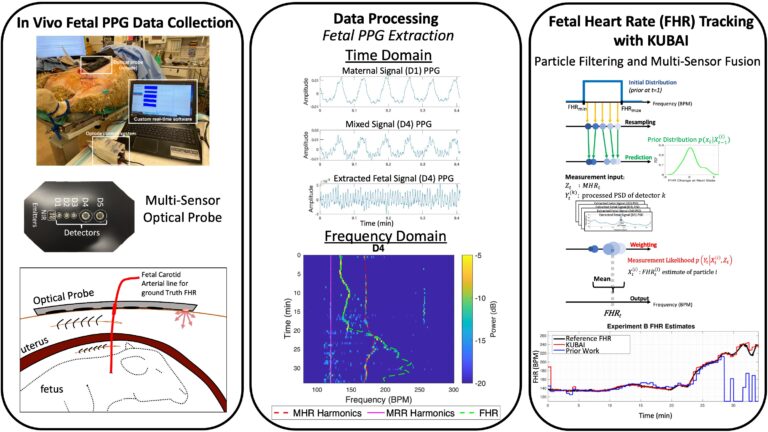Fetal-heart-rate (FHR) is fundamental to assessing the perinatal fetal well-being. Cardiotocography (CTG) is the current technology used to monitor FHR. Unfortunately, CTG is very prone to noise sources such as fetal motion, maternal and fetal breathing, and the placement of the ultrasound transducer requires frequent adjustment. In addition to CTG, researchers have been working on developing a Transabdominal Fetal Pulse Oximetry (TFO) device to provide non-invasive and transcutaneous measurement of fetal oxygen saturation (fSpO2). To compute fSpO2, TFO relies on extraction of FHR from the acquired photoplethysmogram (PPG) signals. Thus, FHR is a precursor to TFO’s fSpO2 computation. However, motions, contractions and other unforeseeable dynamics may substantially degrade the quality of acquired signals, hindering robust tracking of FHR.
We propose KUBAI, a situation-aware particle filtering algorithm that makes use of stochastic sensor fusion. By combining data from multiple sensors, one can achieve higher accuracy and can make more specific deductions compared to single source data. We use data collected from gold standard animal models using TFO to demonstrate the improvement in FHR tracking accuracy.
The accuracy of KUBAI is evaluated against invasive ground-truth measurements. We obtained below 6 beats-per-minute (BPM) root-mean-square error (RMSE) with KUBAI, on five different datasets. KUBAI’s performance is also compared against a single-sensor version of the algorithm to demonstrate the robustness due to sensor fusion. KUBAI’s multi-sensor estimates are found to give overall 23.5% to 84% lower RMSE than single-sensor FHR estimates. The mean±SD of improvement in RMSE is 11.95±9.62BPM across five experiments. Furthermore, KUBAI is shown to have 84% lower RMSE and 3x higher R2 correlation with reference compared to another multi-sensor FHR tracking method found in literature.
The presented method can benefit other multi-sensor measurement setups, which may be challenged by low measurement frequency, low signal- to-noise ratio, or intermittent loss of measured signal.

